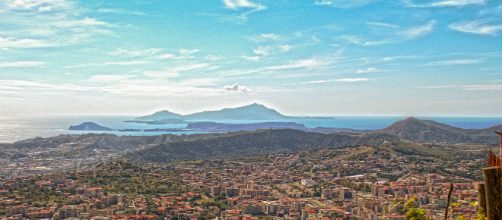Scientists have identified a pattern to the eruptions of the Campi Flegrei in southern Italy, according to a study published on November 14 in Science Advances. The new data could help predict the timing of volcanic eruptions in the future, giving an advance notice for evacuations and other emergency preparations.
What is Campi Flegrei?
Campi Flegrei, Italian for the Phlegraean fields, is a volcano located in the Bay of Naples. The main volcano is surrounded by a caldera, a massive hole in the ground created when a volcano erupts. Calderas can be formed in two ways: during or after an eruption.
The first way is that the gas in the magma expands so quickly when it reaches the surface during an explosion that it pushes chunks of rock away from the site. The second is that after the event, the unstable surface rock collapses into the newly empty underground magma chamber.
Campi Flegrei has had two eruptions big enough to create a caldera, one 39,000 years ago and another 24,000 years after that. The effects of these events combined shaped the topography to what it is today. Campi Flegrei has had minor eruptions multiple times since then; the last was in A.D. 1538. This event created a small mountain and is known as Monte Nuovo—New Mountain. Now, 1.5 million people live in the vicinity of the volcano.
Italy's Campi Flegrei has been curiously eruption-free since 1538. New research unspooled 60,000 years of its history with an eye on what the volcano will do in the future. https://t.co/E0rMSoH6DM
— The New York Times (@nytimes) November 15, 2018
A team of scientists led by Francesca Forni, a postdoctoral researcher at Singapore’s Nanyang Technological University, took samples of layers of rock around the volcano and analyzed the chemistry of each. Altogether, they examined the chemical makeup of rock formed from 23 different eruptions and identified three distinct stages of Campi Flegrei’s explosions.
What are the stages of volcanic eruptions?
The first stage in the cycle is a massive eruption, big enough to cause a caldera like the ones Campi Flegrei had thousands of years ago.
There is only one massive eruption per cycle.
Once the major explosion has weakened the Earth’s crust, more magma is free to come up through the cracks in the surface in lesser amounts. These smaller eruptions are part of the second stage of the cycle. The second stage lasts longer than the first as the volcano erupts again over regular periods of time.
The third stage is the cooling off period. After the volcano has stopped erupting, magma builds up again in underground chambers. This last stage is the longest. As the magma is compiled, it turns into a liquefied form with more water. The water eventually evaporates and these gas bubbles float to the roof of the chamber. Once enough gas is gathered, it causes another major eruption, returning the volcano to the beginning of the cycle.
What does this mean for Campi Flegrei now?
Campi Flegrei is in the third stage of the cycle, but the cycles can last for thousands of years. Experts do not expect the volcano to erupt anytime soon. Some even say that the extended period of dormancy the region is experiencing now could mean that Campi Flegrei is ready to retire, although it has gone through the cycle more than once before.
Right now, the data can only explain how Campi Flegrei acted in the past. The new research is not yet advanced enough to predict when the volcano will erupt, but further study could lead to greater accuracy of the timeline of large volcanic eruptions and a greater understanding of both the past and future landscape of the Earth.


